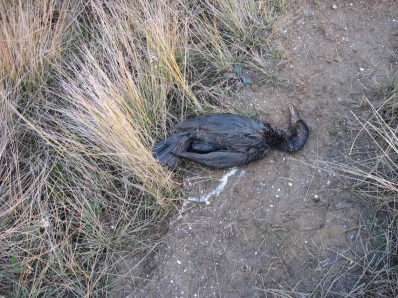Environmental Watch on the North Caucasus
Information Distribution
November 27, 2007
Continues To Be Unconcerned About the Taman Beaches,
Which Are Still Covered in Fuel Oil
A group of activists from Environmental Watch on the North Caucasus is currently on the Taman Peninsula and, together with the Temryuk regional organization, Saving Taman!, is monitoring the situation there following the catastrophic oil spill in the Strait of Kerch.
From the previous trip by Environmental Watch activists on 17-18 November, it was clear that oil pollution cleanup was not taking place along the entire beach. These facts were confirmed by monitoring that was conducted along the beach by activists from Greenpeace Russia. Both Environmental Watch and Greenpeace reported this information to the headquarters of the office for liquidation of the impact of the catastrophe, although it is clear that they were well aware of this problem, even without the information from the public.
However, as the following incidents demonstrate, the polluted kilometers of seashore did not stop the headquarters’ staff from telling the entire country that the impacts of the catastrophe were “practically liquidated” and that the situation “had been transferred to standard procedure.”
This paradoxical situation did not change even after large numbers of the public pointed out that these claims did not correspond with reality. The situation cannot become “standard procedure” when twenty kilometers of beaches that are covered with fuel oil have not been cleaned up.
On November 27 activists from Environmental Watch went to the far point of the uncleaned beaches on the Sea of Azov to the Cape of Pekla, which is close to the village of Kuchugury. Here in the area with the only access to the beach, they discovered some sort of attempt to start working on beach cleanup, but these attempts, it was clear, were unsuccessful. The beach was relatively clean only for several hundred meters, and further on, the beach was covered with fuel oil. In many places, the oiled shoreline was covered with clean shells, which had washed up during the storm. They ran across a lot of dead birds, including those that had only recently died. There were no live oiled birds on this part of the beach. Beach cleanup in this area is definitely difficult as there is no access to the beach (collecting spilled oil in this area is possible only from the sea), and because in many places the fuel oil has seeped in between the cracks among large stones.
On the same day, activists from Environmental Watch were also on the beach near the villages of Kuchugury and Peresyp, as well as near the old Cossack settlement of Golubitsk. It was clear that no beach cleanup had occurred here either.
Activists from Greenpeace Russia cleaned up the beach themselves in the area around the village of Priazovsk today; there were no signs of official attempts at beach cleanup there, either.
Igor Golubenkov, co-chairman of the public organization, Saving Taman!, told us that there also have been no attempts to clean up the beaches between the Capes of Panagiya and Tuzla.
In addition, Environmental Watch received documents composed on November 26 by the commission, which consists of representatives of the local authorities in Temryuk region. These documents officially confirm that the beach in these areas will not be cleaned up.
Here are several quotes from the documents:
“From the village of Ilyich to the Cape of Akhilleon, an expanse of 2.5 kilometers, fuel oil pollution lies in layers with a width of 7-10 meters and a depth of .5-1.2 meters.
From the Cape of Akhilleon to the edge of the village of Kuchugury there are many shell and sandy beach areas, as well as rocky areas, which are polluted with fuel oil.”
“There are massive accumulations of fuel oil in the area around the Azov Pekla (Cape of Pekla), which are impossible to remove without special equipment and technology and because of lack of access.
The expanse of the vulnerable zone is around 3.5 kilometers and is 1-12 meters wide. The depth of the oiled shells and sand is from .5 to 1.2 meters.”
“As a result of the research, it is clear that the area of the Cape of Panagiya has points polluted by fuel oil, fueled seaweed, and shoreline sands that are polluted with fuel oil.”
The commission includes members of the Temryuk Regional Administration, O.V. Kochubey and T.V. Strebkova; Deputy of the Temryuk Regional Council, A.T. Dmitrienko; Head of the Zaporozh rural settlement, A.A. Lyasheno; Deputy Head of the Taman rural settlement, V.V. Lavrentev; and Deputy Head of the Fontalovsk rural settlement, A.V. Derii.
But as today’s events demonstrate, even this did not convince the commission for liquidation of the impacts of the catastrophe to put together the strength necessary to clean the beaches.
In addition, Environmental Watch learned that on November 30 there are plans to wrap up the beach clean up work and announce that the liquidation of the impacts of the environmental catastrophe is “complete.” The authorities are prepared to announce that the liquidation of the catastrophe is complete before the duma elections at any cost.
However, this attempt to exchange reality for what is wished for will have every unpleasant consequences. Fuel oil, which is lying on the beaches, gradually seeps into the shells and sand and will be “preserved” for an unknown period of time. After every strong storm it will again appear in the sea and pollute the beaches, killing birds and scaring tourists. In order to avoid these problems, it is necessary, finally, to begin full-scale work to cleanup the beaches in the areas that are hard to get to, and using the specialized technical and human resources that are needed to complete this work.
Andrey Rudomakha
Environmental Watch on the North Caucasus
Translated by Crude Accountability
Photographs:


